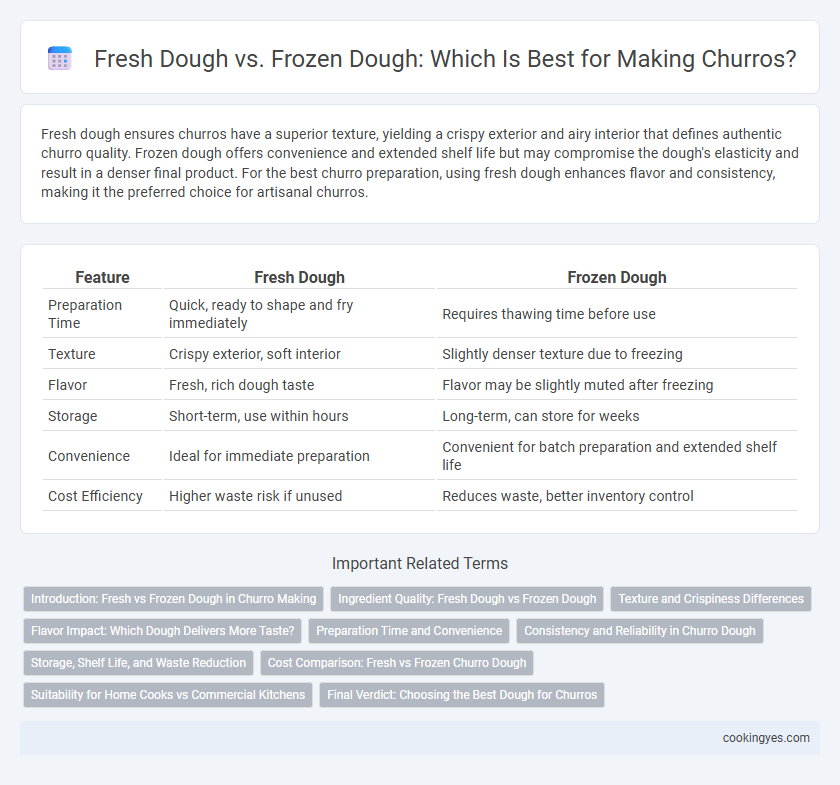Fresh dough ensures churros have a superior texture, yielding a crispy exterior and airy interior that defines authentic churro quality. Frozen dough offers convenience and extended shelf life but may compromise the dough's elasticity and result in a denser final product. For the best churro preparation, using fresh dough enhances flavor and consistency, making it the preferred choice for artisanal churros.
Table of Comparison
| Feature | Fresh Dough | Frozen Dough |
|---|---|---|
| Preparation Time | Quick, ready to shape and fry immediately | Requires thawing time before use |
| Texture | Crispy exterior, soft interior | Slightly denser texture due to freezing |
| Flavor | Fresh, rich dough taste | Flavor may be slightly muted after freezing |
| Storage | Short-term, use within hours | Long-term, can store for weeks |
| Convenience | Ideal for immediate preparation | Convenient for batch preparation and extended shelf life |
| Cost Efficiency | Higher waste risk if unused | Reduces waste, better inventory control |
Introduction: Fresh vs Frozen Dough in Churro Making
Fresh dough for churro preparation offers a softer texture and more authentic flavor due to its higher moisture content and immediate use after mixing. Frozen dough provides convenience and longer storage stability but may slightly compromise the crispiness and lightness typical of traditional churros. Selecting between fresh and frozen dough depends on balancing quality preferences with logistical needs in churro production.
Ingredient Quality: Fresh Dough vs Frozen Dough
Fresh dough for churros maintains superior ingredient quality due to its unaltered texture and moisture content, which enhances flavor and crispiness when fried. Frozen dough often experiences slight degradation in ingredient integrity as freezing can cause ice crystal formation, leading to a compromised gluten structure and diminished flavor profile. Using fresh dough ensures optimal consistency, better absorption of frying oil, and a more authentic churro taste.
Texture and Crispiness Differences
Fresh dough in churro preparation yields a superior texture with a lighter, fluffier interior and a crispier exterior due to its higher moisture content and immediate frying process. Frozen dough tends to absorb more oil during frying, resulting in a denser, chewier texture and less crispiness as ice crystals formed during freezing affect the dough structure. Choosing fresh dough enhances the classic churro experience by preserving ideal moisture levels and achieving optimal crunchiness.
Flavor Impact: Which Dough Delivers More Taste?
Fresh dough for churros provides a superior flavor profile due to its higher yeast activity and moisture content, resulting in a light, airy texture that enhances the cinnamon-sugar coating. Frozen dough often suffers from moisture loss and yeast dormancy, leading to a denser, less flavorful churro. Bakers seeking maximum taste and crispness consistently prefer fresh dough over frozen for authentic churro preparation.
Preparation Time and Convenience
Fresh dough for churro preparation offers superior texture and flavor but requires longer preparation time due to immediate mixing and resting needs. Frozen dough provides significant convenience, allowing for batch preparation and extended storage, which reduces overall prep time on churro-making days. Choosing frozen dough optimizes efficiency in commercial settings while fresh dough is preferred for artisanal quality and taste.
Consistency and Reliability in Churro Dough
Fresh dough offers superior consistency in texture and flavor, ensuring churros have a crisp exterior and tender interior every time. Frozen dough provides reliable shelf life and ease of use but may suffer from slight changes in moisture content, affecting final product uniformity. Choosing fresh dough enhances the authenticity of churros, while frozen dough supports operational efficiency in high-volume settings.
Storage, Shelf Life, and Waste Reduction
Fresh dough for churro preparation offers superior texture and flavor but has a limited shelf life of 1-2 days when refrigerated, requiring prompt use to minimize waste. Frozen dough extends storage up to 3 months, maintaining quality and allowing for batch preparation, which reduces daily waste and operational costs. Optimal freezing and thawing techniques preserve dough elasticity and ensure consistent churro quality while enabling efficient inventory management.
Cost Comparison: Fresh vs Frozen Churro Dough
Fresh churro dough typically incurs higher costs due to immediate ingredient use and labor-intensive preparation, while frozen dough reduces expenses through bulk production and extended shelf life. Frozen churro dough minimizes waste and storage-related costs, offering a more budget-friendly option for businesses with high demand. Cost efficiency depends on factors such as purchase volume, storage facilities, and preparation time, influencing the overall economics of churro production.
Suitability for Home Cooks vs Commercial Kitchens
Fresh dough offers home cooks superior control over texture and flavor, making it ideal for small batch churro preparation. Frozen dough provides consistency and time-saving benefits preferred by commercial kitchens handling high volume production. Choosing between fresh and frozen dough depends on balancing the need for freshness versus efficiency in churro making environments.
Final Verdict: Choosing the Best Dough for Churros
Fresh dough delivers superior texture and a more authentic flavor in churro preparation, ensuring a light, crispy exterior and tender interior. Frozen dough, while convenient and time-saving, often compromises on freshness and can result in denser churros with less crispness. For optimal taste and quality, fresh dough remains the best choice for achieving traditional churros with perfect consistency.
Fresh Dough vs Frozen Dough for Churro Preparation Infographic

 cookingyes.com
cookingyes.com